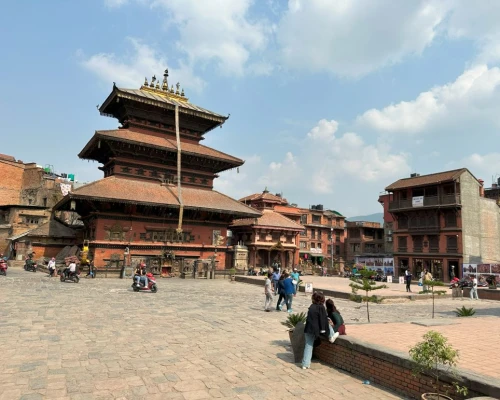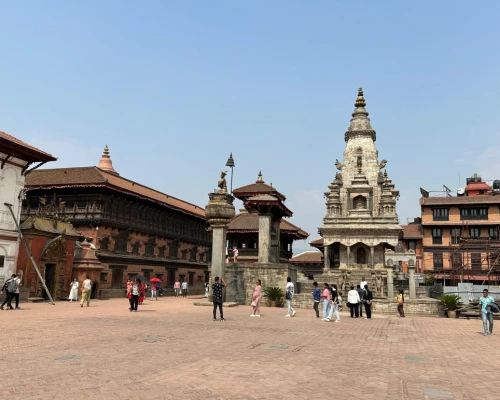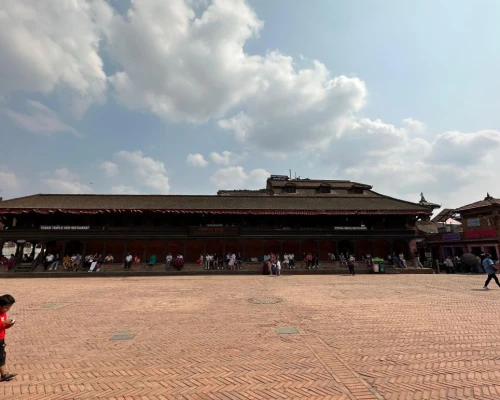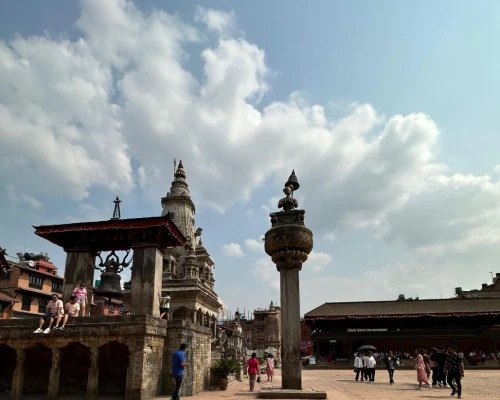Bhaktapur Durbar Square Day Tour Introduction
Bhaktapur Durbar Square Day Tour is a one-day cultural experience specializing in Bhaktapur, a city that is home to Nepal's finest royal square, which is most known for its historically significant temples, magnificent palaces, and naturally vibrant city life. Bhaktapur Durbar Square is an UNESCO World Heritage site, and visiting this unique area will take you back centuries in time.
Bhaktapur will provide you with the spectacular 55 Window Palace, the Golden Gate, the stunning Nyatapola Temple, and the not-so-famous Pottery Square. Guests have the opportunity to stroll through Bhaktapur's narrow winding streets and many squares, all while taking in authentic Newari craft, some culinary delights including Juju Dhau (King Curd), and a multitude of rituals that occur throughout Bhaktapur.
Overall, this tour provides guests with an excellent mix of history, architecture, and varied living heritage, providing you with an incredible experience of this destination, and we are highly confident a worthy stop in your travels through Nepal.
About Bhaktapur and Durbur Square
Located 13km east of the Kathmandu valley, Bhaktapur city is also popular as Bhadgaon or Khwopa. This ancient city is widely known as the city of culture, the city of devotees, or an open museum. It is the home of traditional Nepali culture and unique wooden and pottery art. Each and every piece of art reveals the medieval age culture and tradition of Nepal.
All of the monuments and sculptures reflect the century-old technique of craftsmanship. Truly it is Nepal’s cultural gem. UNESCO World Heritage Site, Bhaktapur Durbar Square, in Bhaktapur allures a large number of domestic and international tourists.
The complex consists of four distinct squares namely Durbar Square, Taumadhi Square, Dattatreya Square, and Pottery Square, however, the whole area is informally known as Bhaktapur Durbar Square. Many people visit this historical place to savour the beauty of the entire Durbar location. The spellbinding archaic beauty of the palace captivates any travellers. One’s visit to Nepal is incomplete without a reminiscing tour in Bhaktapur.
Bhaktapur Durbur Square Tour Main Highlights
- Come visit historic temples and palaces, some of which are older than 1000 years.
- Take in all the stone carvings, as well as the large wooden carvings and carvings on the temples and palaces.
- Walk through the local markets, visit the shops.
- Take pictures of the 55-Window Palace and enjoy the construction process of the amazing structure.
- Visit the beautiful design of the Vatsala Temple.
- Enjoy the amazing Newari architecture.
- You will be able to taste some Nepali snacks on the street from street vendors.
- You experience local festivals and culture.
- You see the famous Lion's Gate and Golden Gate.
- Relax in public squares that have a great history.
History of Bhaktapur Durbar Square
After the establishment of the Bhaktapur Durbar Square in the 12th century, the Palace there had altogether 99 courtyards. However in the 18th century, out of 99 courtyards only 12 remained and today they are merely half that number.
Really, it is very difficult to determine the exact history of the Palace buildings. However, it is believed that the city was founded by the Malla King named King Anand Malla in the 12th century. In addition, the Kathmandu Valley was once ruled from Bhaktapur by the Mallas, until King Yakshya Malla divided the kingdom among his three sons in 1482 AD. Thereafter until the mid 18th century, Bhaktapur saw many battles.
Along with the division of the valley kingdoms, the Shah dynasty conquered them one after another.
During this time the city not only faced battles and fights, but it also saw the great flourishment in the culture, art, and architecture. Mallas are the ones who began to flourish the fantastic art and sculptures in the city. Undoubtedly, the Malla reign contributed a lot to making the Bhaktapur city more cultural and architectural.
Despite being close to the Kathmandu Valley the elegant art, fabulous culture, vibrant festivals, traditional dances, and indigenous lifestyle of the Newari people retain the ancient beauty of the Bhaktapur. You can still see the women of Bhaktapur in the traditional Newari attire which is referred to as Haku Patasi in the Newari language.
The majority of people here are farmers. They produce household items like clay pots, straw mattresses, clothes, and many more. Besides these, they also produce the JUJU DHAU, which you should taste during your visit to the Bhaktapur Durbar Square.
If you visit Bhaktapur city on the 1st day of the Nepalese New Year, you will get to see the BisketJatra. During this vibrant festival, chariots are pulled through the streets. Eventually, a tug of the war determines who will be blessed with good fortune in the upcoming year.
Private and Customizable One day Bhaktapur Tour in 2026, 2027
Our one-day Bhaktapur tour is designed for a private, custom itinerary based on your interests and wishes.
You can completely custom-tailor your day, you can spend the day exploring Bhaktapur Durbar Square and/or observing the local pottery workshop, and stop at sites such as Changu Narayan Temple or local markets.
We offer the opportunity for private tours for individuals, couples, families, or groups. The benefit of a private tour is that guests can travel at their own pace and without worry. Our experienced tour guides can adjust the pace and sights according to your group.
What are the Main Places you will Visit in Bhaktapur Durbar Square Tour?
1. Bhaktapur Durbar Square
Bhaktapur Durbar Square is a UNESCO Heritage site that serves as a cultural center for Bhaktapur and was once a collection of royal palaces. As a UNESCO Heritage site, the square informs us of the city’s history and tradition and exemplifies the region’s architectural and artistic expression.
The remains of temples, courtyards, and palaces over a century old remind us of the resources and significance of the Malla dynasty. Bhaktapur Durbar Square is an inheritance of culture and craftsmanship from a singular Newari culture.
Highlights:
- UNESCO Heritage site
- Traditional Newari design
- Historic and Royal courtyards
- Museums and exhibit galleries
- Locally handcrafted artisans and shops
2. Dattatraya Square
Dattatraya Square is the oldest square in Bhaktapur and is centered around the ancient Dattatraya Temple that was built in 1427 A.D.. While it is a much quieter space than other areas, it still retains the impressive nature of Bhaktapur and is highly culturally important. It is also well-known for wood carving.
The square holds a great deal of representations of cultural meaning, monuments, maths, and museums that give the visitor a more in-depth experience of the rich artistic and religious heritage of Bhaktapur.
Notable features:
- Ancient Dattatraya Temple
- Woodcarving Museum
- Peacock Window (masterfully crafted design of woodcraft)
- Worshipful theme of serenity
- Traditional Newar homes
3. 55 Window Palace
The 55 Window Palace (Pachpanna Jhyale Durbar) is probably the most famous and iconic building in Bhaktapur. It was built by King Bhupatindra Malla, who had the 55 window palace built with its balcony and 55 carved wooden windows.
The 55 window palace is not all open to the public, as the structure is part of the Bhaktapur Durbar Square Museum, part of history that carries visitors back to the splendid dimension of craftsmanship of the Malla period.
What you can expect to see at the 55 window palace:
- Iconic 55 carved windows
- Former royal palace of the Malla kings
- An architectural masterpiece
- Part of the National Art Museum
- Intricate wood and brickwork
4. Pottery Square
Pottery Square represents an active tradition of pottery. Artisans are thinking about lumps of clay, hand-crafting or wheel throwing them, and then drying their potted clay objects in sunny open-air courtyards.
You get to see pottery in real time, and even do some of your own pottery making, from wheel to kiln, and then take some home. The highlights of Pottery Square include:
- How traditional pottery is made, in action
- A bright sunny courtyard of drying clay pottery
- Local artisans making their piece of work
- Pottery experience - hands-on
- Shopping experience at the souvenir store
5. Bhairab Nath Temple
In the middle of Taumadhi Square stands the Bhairab temple. The Bhairab temple has a long history as well. The temple here was once a small building located within the larger pagoda-style temple constructed in the 18th century.
Bhairab is also the 'protector deity' of Bhaktapur, where the Bhairab temple serves as the focus of festivals like Bisket Jatra.
Key features:
- 3-tiered pagoda-style structure
- Shrine of Bhairab (the female form of Shiva).
- Bhairab is featured prominently in the festivities during the Bisket Jatra.
- An ancient bronze sculpture and woodwork.
- The temple has historic, religious, and cultural significance.
6. Nyatapola Temple
Nyatapola Temple is the tallest pagoda temple in Nepal, built in 1702 AD. The temple has five stories employing Newari architecture.
The temple is dedicated to Siddhi Lakshmi, a Tantric goddess. The stairway is guarded by stone wrestlers, elephants, lions, and griffins, indicating strength and protection.
Tour highlights:
- The tallest temple in Nepal.
- Five-story pagoda-style temple.
- Treasure is even hygienically protected inside the temple for Siddhi Lakshmi.
- Stone muscle guardians are super impressive.
- Built with engineering to withstand earthquakes.
7. Taumadhi Square
Taumadhi Square is an energetic and lively square situated between the Nyatapola and Bhairab Nath Temples. Taumadhi Square acts as a celebration and festival space showing a mixture of culture, spirituality, and everyday lives, all with shops, shrines, street vendors, and so on.
Highlights:
- Home to Bhairab Nath & Nyatapola temples
- City centre for festivals
- Traditional Newari style architecture
- The people of Taumadhi Square and their lives
8. Batsala Temple
Batsala Temple is a Shikhara Temple that is devoted to Batsala Devi and is a stone temple with incredible carvings; a large bronze bell known as the "Bell of Barking Dogs" is a famous feature of the temple.
The original temple was damaged during the 2015 earthquake, and the work that remained has kept the temple looking very nice.
Highlights:
- Shikhara style temple
- Batsala Devi temple
- Intricate stone carving work
- Barking Dog bronze Bell
- History and spiritual experience
9. Mini Pashupatinath Temple
Located next to the main Durbar Square, this temple, dedicated to Lord Shiva, is the world's smallest version of the world-famous Pashupatinath Temple in Kathmandu. The temple's unique, top-of-the-hill and open-air situation makes it particularly potent with local ritual around the square.
Though there might be some smaller temples, it is still a temple with religious significance and features on the culture and background of Shiva worshipping in Bhaktapur.
Highlights:
- Shiva temple replica
- Religious significance
- Small and sacred place
- Fine and ornate wood and stone
- Quiet space for an experience and atmosphere within the square
10. Golden Gate
The Sun Dhoka, or Golden Gate, is a gold-plated entrance to the 55 Window Palace in Kathmandu. The stunning sea creatures and gods make it perhaps the most visually breathtaking piece of metal carving in Nepal.
Although the Golden Gate is both a spectacular piece of metal, it is the physical entrance into the inner courtyards of the palace.
Features:
- Entrance to a 55-window palace
- A stunning piece of gold-plated art
- The carvings of the Hindu god and other sea creatures
- One of the best doors in Nepal
- A Symbol of royal opulence
Fully Guided Bhaktapur Durbar Square Full Day Tour With Mountain Rock Treks
We employ licensed, English-speaking, and culturally trained guides who are experts and bring the local Malla-era stories of Bhaktapur people to life. For instance, while touring the Golden Gate and 55-Window Palace, the guides will narrate Malla-period history and local stories that will allow you to understand Bhaktapur better.
The tour is not just walking; you get to move at your own pace, have insider access to the artisan quarters of Pottery Square, and a stress-free day with the transport back and forth from your hotel in Kathmandu all arranged.
Extra Benefits with Our Company:
- Private vehicle door-to-door pickup & drop-off
- Government-licensed guide trained in history & culture
- Assistance with all entry permits
- Small group sizes (guided attention & comfort)
- Flexible stops at temples, handicraft shops, and local eateries
Bhaktapur Durbar Square Day tour Package Price 2026, 2027
The price for the Bhaktapur Durbar Square Day Tour package starts at $65.00 per person, with all packages being inclusive.
The value is usually based on a guided tour range with an accredited and qualified person, to show you around Bhaktapur's stunning square, including three points of interest, cultural/historical detail, and great knowledge, that we guarantee when you visit a UNESCO World Heritage Site, you see fully.
Departure Time for Bhaktapur Durbur Square Day Tour
You will depart for your Bhaktapur Durbar Square Day Tour each day from your Kathmandu hotel at 10:00 AM, when a private car and driver will collect you, and there are most likely no delays involved.
Since it is a fixed time every day, you can relax when you wake up in the morning, and then you can enjoy the culture of the ancient city of Bhaktapur to the fullest.
If you decide you would like to do this last minute, we generally accept last-minute bookings. Simply contact us and we can assess the situation and organize a tour for you even if you wish to make a same-day reservation.











